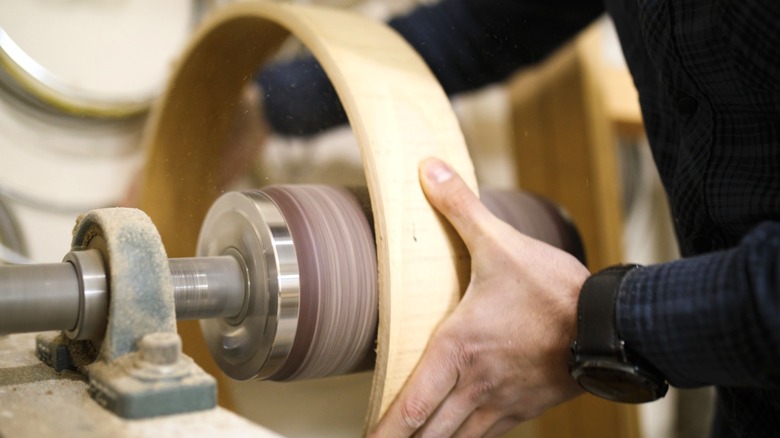The Smart Glue Hack That Helps You Bend Wood For Rounded Projects
Achieving a curved wood aesthetic can seem like magic, but there's a neat woodworking effect that can be surprisingly simple, no matter your skill level. You can try using steam to bend wood or laminate sections for a flawless look if you have the know-how and resources. For those short on time, money, and equipment, though, kerf bending is the accessible solution for quick and easy results. Parallel kerfs, or small slits, give wood room to bend, with multiple tightly spaced cuts supplying the radius and curve length your project demands in only a few minutes. Apply glue to the kerfs, and you'll have a sturdy bend you can use with all kinds of projects.
To bend wood this way, you'll cut straight slits in a piece of wood, such as plywood, across its full width. The cuts go almost all the way through, leaving a small amount of wood (e.g., ~1/16th of an inch) to keep the piece connected. Space several of these kerfs close and parallel to one another, and you can make tight curves around any form.
Do a dry test run on a spare piece of wood before committing to the spacing and cut depth to ensure the curve works and won't break. After making your final cuts, you can add glue to the joints, pushing it into the cracks to fill the gaps. Clamp the bend in its final position, and clean any glue that seeps out. Let the glue set, and sand the connections smooth to finish up!
Tips for gluing your kerf bent wood pieces
Choosing the best type of glue is possibly the biggest concern when you get to that stage of your wood-bending project. You need something hassle-free to clean as the glue pushes out of the gaps when you clamp it. You also don't want a fast-drying glue, as you may need to make adjustments before it gets tacky. PVA wood glue is an excellent choice in both regards. Others have used polyurethane glues, like Gorilla Glue, that can expand to better fill the gap, but it won't necessarily add more strength. Epoxy is another strong glue that can pack a punch with plastics, wood, and many other materials, with good gap-filling properties that can ensure a strong hold. The only issues are that it is more expensive and generally harder to work with than wood glue.
In terms of aesthetics, mixing in sawdust or sanding dust with your glue can help cover the kerf marks, though you likely won't get a perfect color match. You can also use wood filler, matching the wood tone as much as possible to smoothly blend it in. On the inside of the curve, you may want to add a veneer. Gluing a thin sheet along the inside of the bend can reinforce the kerfs. Some builders have also used splines to great effect, cutting perpendicular notches connecting the kerfs and gluing in wood biscuits that are then trimmed and sanded.
